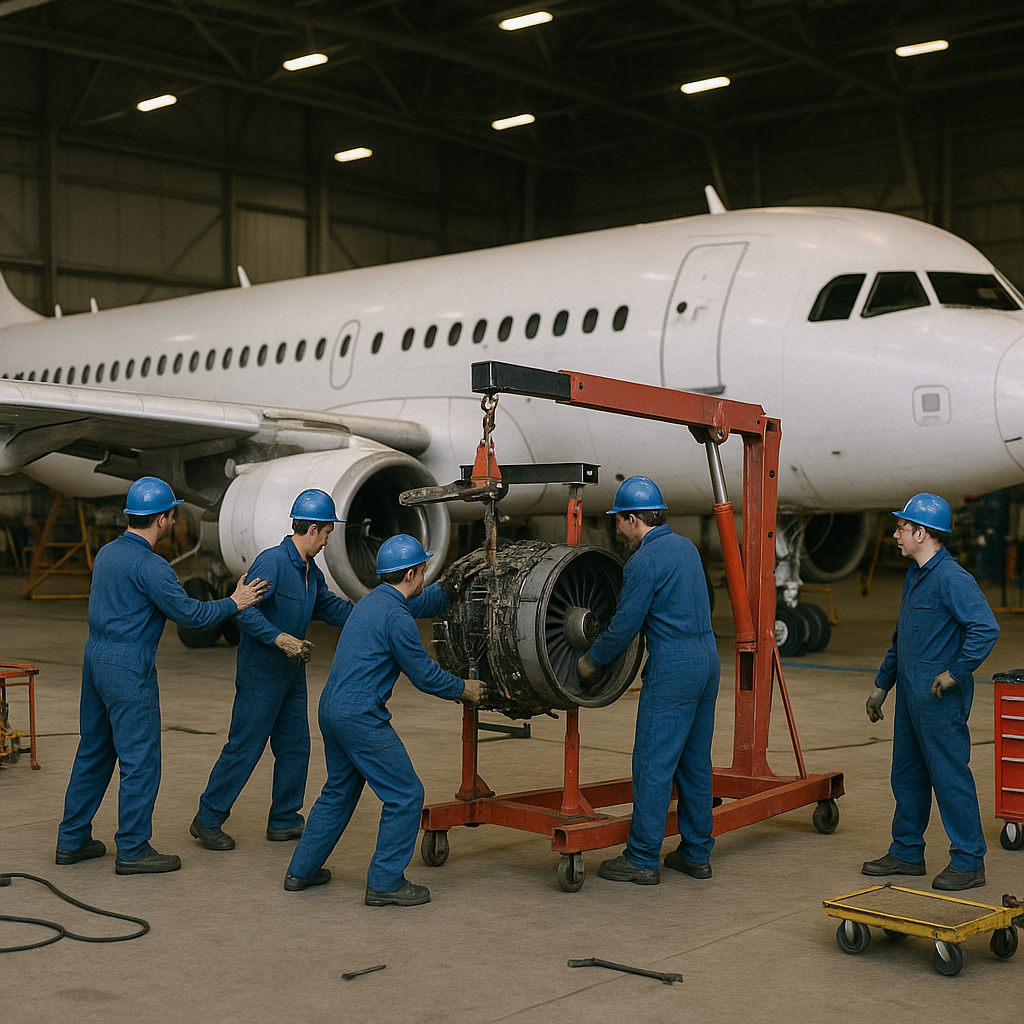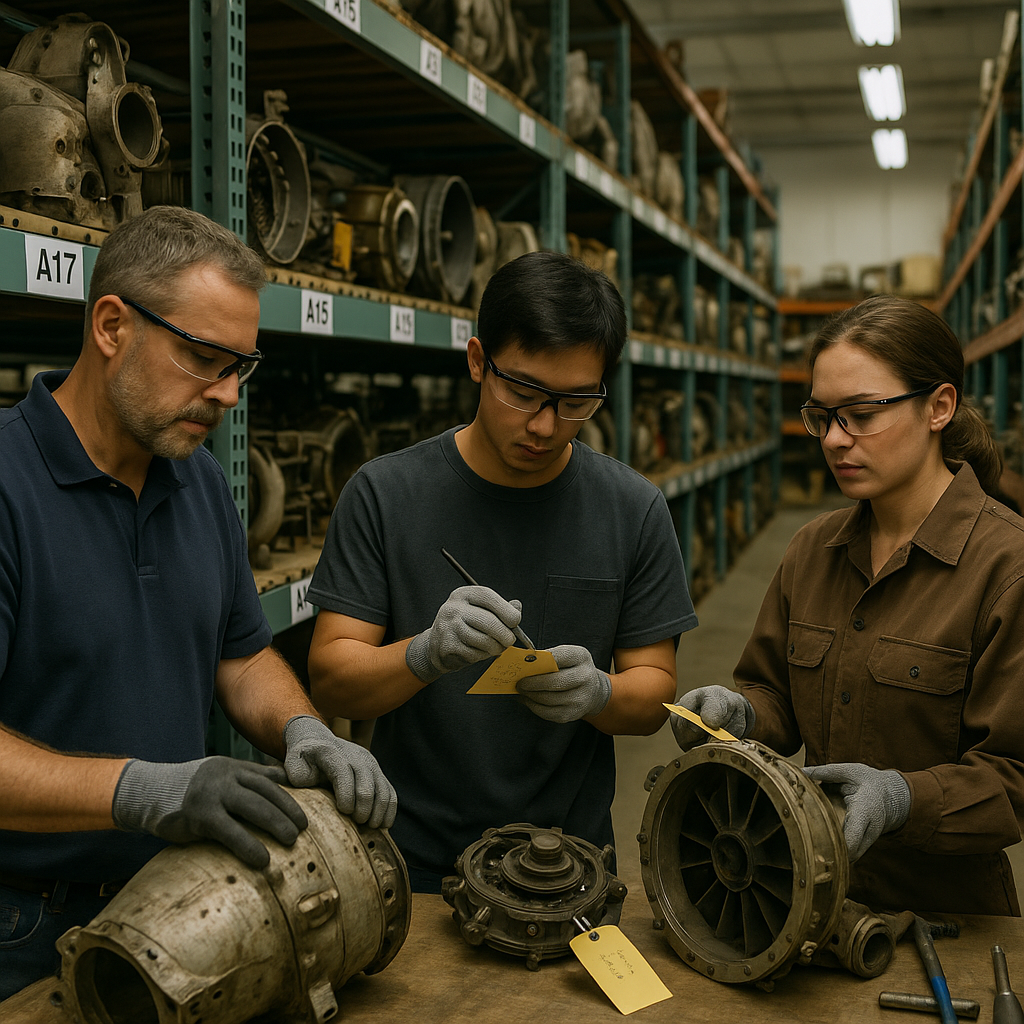5901 Botham Jean Blvd, Dallas, TX 75215
What is the Process for Scrapping a Commercial Airplane in the USA?
July 30, 2025Each year, approximately 400-450 commercial aircraft reach the end of their operational life and enter the recycling stream, driving a $2 billion aircraft parts market. These flying giants, after decades of service, do not simply disappear – they undergo a carefully orchestrated dismantling process that recovers valuable materials and prevents environmental contamination.
The journey of an aircraft’s end-of-life begins at specialized facilities known as “boneyards” or aircraft recycling centers, strategically located in dry, desert regions like Arizona and California. These arid environments minimize corrosion and preserve aircraft components during storage and dismantling. Popular locations include Pinal Airpark, Phoenix Goodyear Airport, and the Mojave Air and Space Port.
Before any dismantling occurs, the aircraft undergoes a thorough decommissioning process. Technicians drain all hazardous fluids – including fuel, hydraulic oils, and coolants – following strict environmental regulations. Other potentially dangerous components like batteries, emergency oxygen systems, and fire extinguishers are carefully removed. For older aircraft manufactured before the 1980s, special attention is paid to identifying and properly disposing of materials like depleted uranium, which was sometimes used as ballast.
Regulatory Compliance and Industry Standards in Aircraft Scrapping
Scrapping a commercial airplane in the United States involves more than just dismantling and recycling; it demands strict compliance with a complex framework of regulatory and industry standards. Both federal agencies and international organizations are crucial in ensuring the process safeguards workers, the public, and the environment, while also maintaining the integrity of the aviation supply chain.
Federal Oversight and Environmental Protection
The Environmental Protection Agency (EPA) establishes guidelines for handling and disposing of hazardous materials like fuels, lubricants, and batteries to prevent soil and groundwater contamination. The Federal Aviation Administration (FAA) oversees certification and resale of used aircraft parts, ensuring only components meeting airworthiness standards are reintroduced into service. Additionally, the Occupational Safety and Health Administration (OSHA) enforces worker safety standards throughout the dismantling and recycling phases.
Industry Best Practices and International Guidelines
Certified recycling facilities commonly adhere to standards set by the Aircraft Fleet Recycling Association (AFRA) and the International Air Transport Association (IATA). These organizations provide best practices for environmentally responsible disassembly, material recovery, and documentation. Adhering to these protocols ensures each phase of aircraft recycling—from fluid drainage to parts resale and materials sorting—is conducted transparently and sustainably.
Compliance with these regulations and industry standards is not only a legal requirement but also reinforces public confidence in aircraft recycling and enhances the global reputation of the U.S. aviation sector. As the industry evolves, ongoing updates to guidelines and increased collaboration between regulatory bodies and recyclers will continue to shape best practices for safe, responsible aircraft scrapping.
Initial Inspection and Documentation

The first step in scrapping a commercial airplane is a meticulous inspection and documentation process. Upon arrival at the recycling facility, aircraft are logged into inventory, and their ownership status, model type, and maintenance records are reviewed. Regulatory compliance is critical—technicians check FAA registration, airworthiness certificates, and export controls to ensure all activities meet federal and international standards.
Every major component is catalogued with photographic records documenting the aircraft’s condition before dismantling. Serial numbers for engines, avionics, and critical assemblies are recorded to ensure traceability and compliance with resale markets and aviation authorities. This thorough documentation protects both the recycling company and future buyers of used components.
Environmental and Safety Planning
A pre-dismantling environmental assessment identifies any lingering hazardous materials, such as asbestos insulation, radioactive exit signs, or mercury switches, which may require specialized handling. The facility also develops a site-specific safety and work plan, including the use of protective equipment and fire prevention measures, to guard against residual flammable vapors or accidental electrical discharge.
Aircraft Disassembly: Step-by-Step

After the initial inspection and draining of fluids, the physical dismantling of the aircraft begins. The process follows a systematic approach designed to maximize material recovery and minimize risk:
- Removal of Valuable Components: Engines, auxiliary power units (APUs), avionics, landing gear, and control surfaces are removed first. These items often have the highest residual value and are frequently refurbished for reuse or resale in the global aviation market.
- Stripping the Cabin and Fuselage: All interior elements—seats, galley equipment, wiring, and insulation—are carefully extracted. Reusable items are set aside, while non-recyclable materials are sorted for proper disposal.
- Structural Disassembly: With the aircraft largely gutted, technicians use cranes, cutting torches, and hydraulic shears to break down the airframe. The wings, tail section, and fuselage are separated into manageable pieces for further processing. Special care is taken with composite materials, which may require different cutting tools than traditional aluminum airframes.
- Sorting and Staging: Dismantled components are staged by material type—aluminum, titanium, steel, and composites—preparing them for subsequent recycling or disposal operations.
This staged disassembly ensures safety standards are upheld while maximizing the quantity and quality of materials recovered for reuse and recycling.
Valuable Parts Recovery and Reuse

A defining feature of aircraft recycling in the USA is the strong emphasis on parts recovery and reuse. Many components, such as engines, avionics, and landing gear, are highly sought after in the secondary market, supporting both commercial aviation and smaller regional or cargo operators. After removal, these parts undergo rigorous cleaning, non-destructive testing, and certification to ensure continued airworthiness.
According to the Aircraft Fleet Recycling Association (AFRA), up to 90% of a retired aircraft’s value may lie in its reusable components. Certified recyclers adhere to industry standards for quality and traceability, providing detailed records for each salvaged part. This practice not only extends the useful life of valuable resources but also reduces the demand for newly manufactured components, decreasing the overall environmental impact of aviation maintenance and operations.
Parts that cannot be reused are responsibly processed for material recovery, ensuring that even lower-value components contribute to the circular economy.
Materials Separation, Recycling, and Environmental Management
With the aircraft stripped to its structural elements, the final phase focuses on materials separation and environmental stewardship. Modern commercial airplanes contain a complex mix of metals (aluminum, titanium, steel), composites (carbon fiber, fiberglass), and smaller quantities of specialty materials like copper wiring and rare earth magnets. Advanced shredders, separators, and sorting technologies are used to segregate these materials by type and purity.
Metal Recovery and Recycling
Aluminum makes up more than 50% of most airframes and is readily recycled for use in new aircraft, vehicles, or consumer products. High-strength titanium and steel are also recovered and returned to the industrial supply chain. These recycling activities significantly reduce the energy use and carbon emissions associated with mining and refining new metals.
Managing Hazardous and Non-Recyclable Waste
Residual hazardous materials—such as heavy metals, old wiring insulation, or specialized composite panels—are isolated and disposed of according to EPA and state regulations. Facilities employ water treatment systems, air quality controls, and secure landfill practices to protect the environment from contamination. Increasingly, research is focused on improving recycling rates for composites and other challenging materials, with new techniques emerging to recover glass fibers and resins for secondary applications.
Through careful separation, recycling, and waste management, the aircraft scrapping industry in the USA is helping to close the loop on aviation materials while supporting broader sustainability goals.
Conclusion: The Future of Commercial Aircraft Recycling in the USA
As the global airline fleet continues to expand and age, efficient and environmentally responsible aircraft recycling becomes increasingly essential. The USA is at the forefront of this progression with its established network of specialized recycling facilities and ongoing technological innovations. American companies are actively developing improved methods for handling composite materials, addressing one of the industry’s most significant challenges.
The aircraft recycling sector in the USA is projected to experience substantial growth, reaching an estimated $6.3 billion by 2030 with a CAGR of over 8%. This growth reflects both economic opportunities and a fundamental shift towards sustainability in aviation. As airlines upgrade to more fuel-efficient models to meet environmental targets and reduce costs, the steady stream of decommissioned aircraft ensures continued demand for advanced recycling solutions.
The future of this industry goes beyond managing waste. By recovering valuable materials like aluminum and titanium while safely disposing of hazardous components, aircraft recycling facilities contribute to a true circular economy in aviation. Each recycled aircraft provides resources for the next generation of flights, reducing the environmental footprint of the aviation industry as a whole. For your recycling needs, contact Okon Recycling at 214-717-4083.
